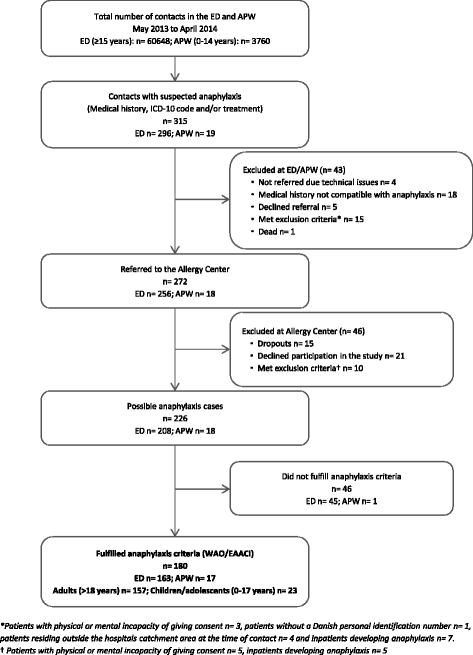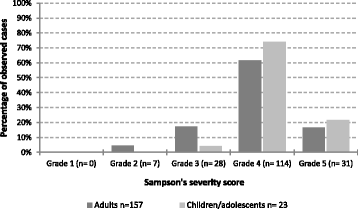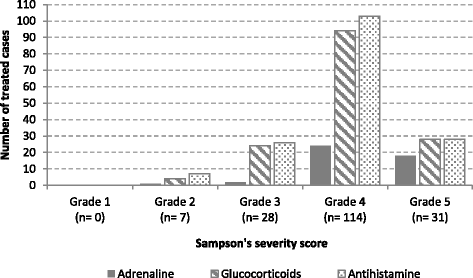Anaphylaxis in an emergency care setting: a one year prospective study in children and adults
- PMID: 29166906
- PMCID: PMC5700668
- DOI: 10.1186/s13049-017-0402-0
Anaphylaxis in an emergency care setting: a one year prospective study in children and adults
Abstract
Background: Current data on anaphylaxis is based on retrospective and register based studies. The objective of this study was to describe the epidemiology of anaphylaxis in a 1 year prospective study at the emergency care setting, Odense University Hospital, Denmark (2013-2014).
Methods: Prospective study at the emergency care setting, Odense University Hospital, Denmark (2013-2014). To identify anaphylaxis cases, records from all patients with clinical suspicion on anaphylaxis or a related diagnosis according to the International Classification of Diseases 10 and from patients treated at the emergency care setting or at prehospital level with adrenaline, antihistamines or glucocorticoids were reviewed daily. The identified cases were referred to the Allergy Center, where a standardized interview regarding the anaphylactic reaction was conducted. International guidelines were applied for the assessment of anaphylaxis and its pharmacological treatment. Severity of the anaphylactic reaction was evaluated according to Sampson's severity score.
Results: We identified 180 anaphylactic patients. Anaphylaxis represented 0.3%-0.4% of all contacts in the emergency care setting with an incidence rate of 26.8 cases per 100,000 person years (95% CI: 14.3-45.8) in children and 40.4 cases per 100,000 person years (95% CI: 32.8-49.3) in adults. Moderate to severe anaphylaxis was registered in 96% of the cases. Skin (96%) and respiratory (79%) symptoms were the most frequent registered, but 7% of cases in adults occurred without skin manifestations. The most common elicitor in children was food (61%), while drugs (48%) and venom (24%) were the main suspected elicitors in adults. Adrenaline was administered in 25% of the cases and it was significantly less administered than glucocorticoids (83%) and antihistamines (91%). The mortality rate during our study period was 0.3 cases per 100,000 person years.
Discussion: This is one of the first prospective studies on the epidemiology of anaphylaxis in children and adults, where the patients are identified not only based on diagnosis codes but also on history, symptoms and treatment and thereafter classified according to international diagnosis criteria for anaphylaxis. A limitation of this study is that only patients who gave consent to participate in the study were included. Furthermore, patients may have attended other hospitals during the study period. Therefore, the estimates are minimum figures.
Conclusion: The prospective study design with a broad search profile yield a higher incidence than previously reported. Adrenaline was administered in a low proportion of the patients with moderate to severe anaphylaxis. Standardized diagnosis criteria among physicians treating anaphylaxis are needed.
Keywords: Anaphylaxis; Epidemiology; Incidence; Prevalence; Symptoms; Treatment.
Figures



Similar articles
-
Pre-hospital treatment of bee and wasp induced anaphylactic reactions: a retrospective study.Scand J Trauma Resusc Emerg Med. 2017 Jan 14;25(1):4. doi: 10.1186/s13049-016-0344-y. Scand J Trauma Resusc Emerg Med. 2017. PMID: 28088250 Free PMC article.
-
Prehospital and In-Hospital Treatment with Adrenaline and Related Prognosis in Anaphylaxis Patients.Int Arch Allergy Immunol. 2024;185(7):678-687. doi: 10.1159/000536315. Epub 2024 Mar 11. Int Arch Allergy Immunol. 2024. PMID: 38467120
-
Patterns of anaphylaxis after diagnostic workup: A follow-up study of 226 patients with suspected anaphylaxis.Allergy. 2017 Dec;72(12):1944-1952. doi: 10.1111/all.13207. Epub 2017 Jun 20. Allergy. 2017. PMID: 28543193
-
Management of anaphylaxis in children.Pediatr Emerg Care. 2008 Dec;24(12):861-6; quiz 867-9. doi: 10.1097/PEC.0b013e31818ea116. Pediatr Emerg Care. 2008. PMID: 19092569 Review.
-
Recognition and treatment of anaphylaxis in the school setting: the essential role of the school nurse.J Sch Nurs. 2013 Dec;29(6):407-15. doi: 10.1177/1059840513506014. Epub 2013 Sep 23. J Sch Nurs. 2013. PMID: 24062364 Review.
Cited by
-
IgE-Mediated Food Allergy.Clin Rev Allergy Immunol. 2019 Oct;57(2):244-260. doi: 10.1007/s12016-018-8710-3. Clin Rev Allergy Immunol. 2019. PMID: 30370459 Review.
-
Anaphylaxis management in a French pediatric emergency department: Lessons from the ANA-PED study.Clin Transl Allergy. 2023 Aug;13(8):e12289. doi: 10.1002/clt2.12289. Clin Transl Allergy. 2023. PMID: 37632240 Free PMC article.
-
Anaphylaxis: first clinical presentation, subsequent referral practise, and suspected elicitor-an observational study.Intern Emerg Med. 2024 Oct;19(7):2047-2056. doi: 10.1007/s11739-024-03589-5. Epub 2024 Apr 10. Intern Emerg Med. 2024. PMID: 38598086 Free PMC article.
-
[Paediatric Life Support].Notf Rett Med. 2021;24(4):650-719. doi: 10.1007/s10049-021-00887-9. Epub 2021 Jun 2. Notf Rett Med. 2021. PMID: 34093080 Free PMC article. Review. German.
-
Anaphylaxis in a Swiss university emergency department: clinical characteristics and supposed triggers.Allergy Asthma Clin Immunol. 2024 May 31;20(1):35. doi: 10.1186/s13223-024-00901-y. Allergy Asthma Clin Immunol. 2024. PMID: 38822425 Free PMC article.
References
-
- Lieberman P, Camargo CA, Jr, Bohlke K, Jick H, Miller RL, Sheikh A, et al. Epidemiology of anaphylaxis: findings of the American college of allergy, asthma and immunology epidemiology of anaphylaxis working group. Ann Allergy Asthma Immunol. 2006;97(5):596–602. doi: 10.1016/S1081-1206(10)61086-1. - DOI - PubMed
MeSH terms
Substances
LinkOut - more resources
Full Text Sources
Other Literature Sources
Medical

